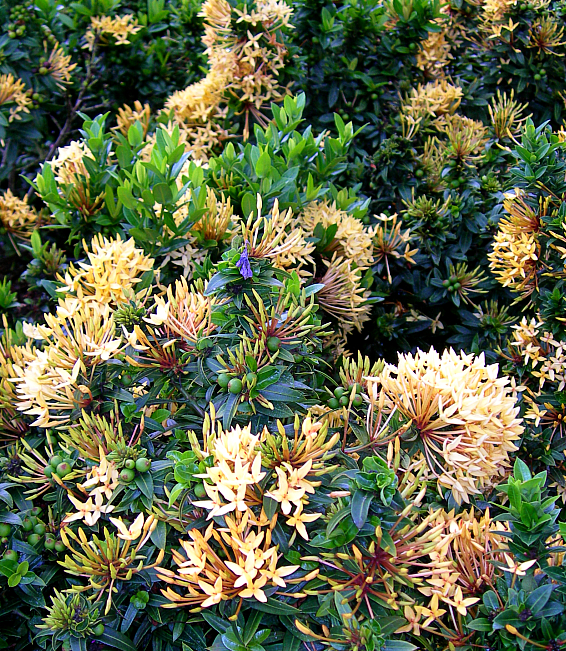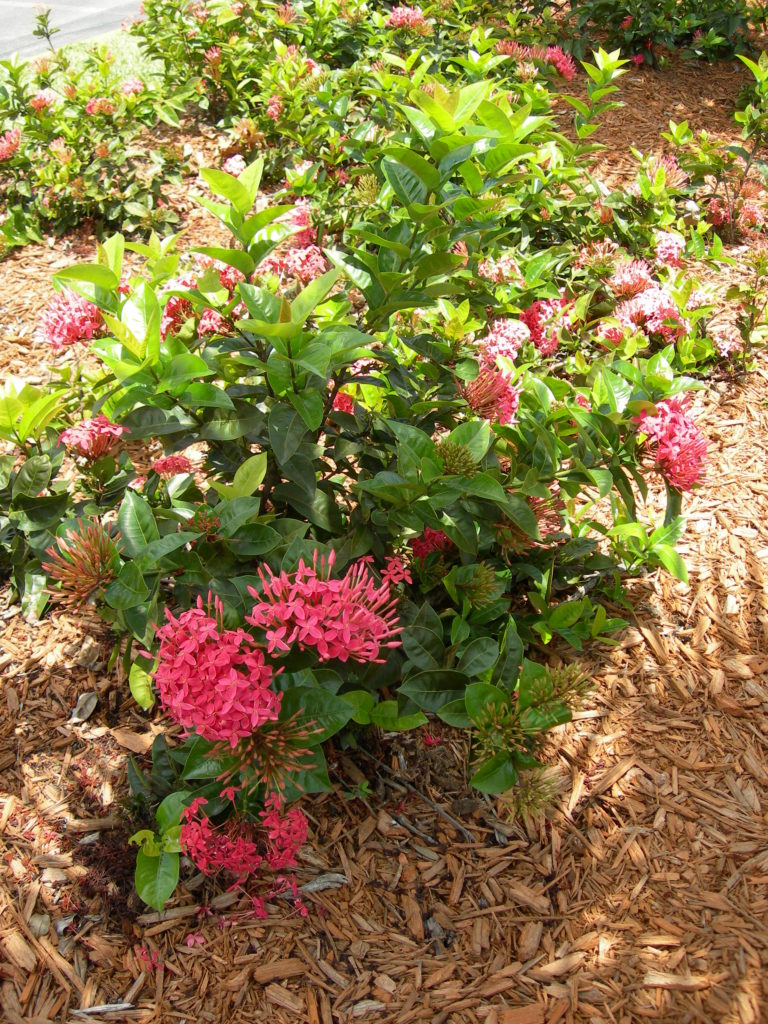Rubiaceae is a flowering plant family known as the madder or coffee family. It is a variable family; the plants are trees, shrubs, woody vines, or herbs. They have opposite or whorled leaves, stipules, and flowers with tubular corollas. Most Rubiaceae plants grow in the world’s warm areas and produce showy flowers. Some of the plants classified in the family include Ixora, Partridgeberry, Psychotria, Coffea, Gardenia, Hamelia, and Pentas. Let’s take a look at Ixora and the spring hard-cut prune.

Ixora is an acid-loving plant. That means it prefers a soil pH of around 5. Many soils in South Florida have a pH of 7 or higher, which is too high for Ixora. High pH soils cause iron and manganese deficiencies, the symptoms of which are yellowing leaves, small new growth, and sometimes bud drop. Correcting this problem is best accomplished by applying chelated micro-nutrients regularly according to the label directions.
As winter guests or residents leave Florida, many landscapers perform a “hard cut” on landscape shrubs, particularly Hibiscus and Ixora. A hard cut is a pruning technique. Typically, it involves cutting a plant within a foot or two of the ground or cutting all the leaves and branches off a tree. It is a widespread technique as a quick and dirty way to reduce a plant’s size, particularly for plants installed in a space too small for the mature plant. A typical example of this is the spring pruning of plants such as Ixora, Ligustrum, Podocarpus, and Hibiscus planted in a three-foot-wide bed next to the house under windows three feet off the ground. In this situation, regular shearing and hard cuts are used to keep the plants in bounds.
What is wrong with pruning a plant this much or using a hard cut once or twice a year? This practice is detrimental to the plants. Pruning, by its nature, causes plant wounds. Sometimes branches are severely cut, and dieback occurs, causing brown, ugly sticks in the shrub. These seriously damaged branches do not regrow well or at all.

Hard pruning also takes most of the leaves off a shrub, removing the engines that produce the food/energy needed to regrow the plant. If a plant does regrow, the branches which form after a hard cut are often spindly and do not grow into a robust and pleasing shape. Once a plant is damaged from severe pruning, they become susceptible to more frequent and severe pest infestations.
Hard cuts cause damages that reduce the lifespan of the plant. Many plants will live for decades or longer if maintained well. However, the valuable life is measured as the timespan when a plant looks good. For shrubs growing in a heavily pruned situation, that timespan is between 5 and 10 years. As the plants begin to decline, some folks harangue the landscaper to “do something” to make the plants look good again. No amount of water, fertilizer, pest control, or pruning will produce a plant that has been abused to look good and grow again. At this point, plant replacement is the best way for the landscape to look good again.
Better pruning practices for a healthy, long-lived landscape start at planting. Choose plants that will fit the spot at maturity. Hand prune to thin, head back, or shape as needed. Avoid repeatedly shearing the branch tips. When flowering plants such as Ixora are constantly sheared, the flower buds are removed, so they don’t flower or flower poorly. The general rule is to prune so that no more than 30% of the top growth is removed. This pruning practice produces healthier plants, shrubs, turf, and trees. Just say no to hard cuts for Ixora and other landscape plants. Check out more April gardening tips here!
Leave a Reply